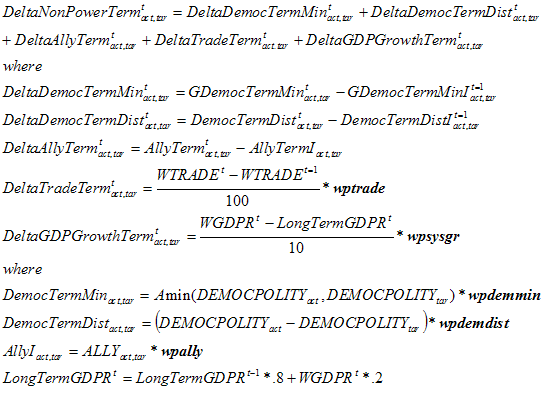International Futures Help System
IP Equations: Non Power Term for Threat
The threat calculation builds on an initial, constant term plus a delta power term (that is a change in power term) and a delta non-power term. This topic explains the non-power term (DeltaNonPowerTerm). It is a sum of five other terms: delta minimum democracy term (DeltaDemocTermMin), delta democracy distance term (DeltaDemocTermDist), delta alliance term (DeltaAllyTerm), delta trade term (DeltaTradeTerm), and delta GDP growth term (DeltaGDPGrowthTerm). See the Initial Threat Topic for a discussion of the foundational elements of the first three of these. The delta term for each is the foundational term in a future year minus the initial value of the term. The two new terms in future years are the delta trade term (DeltaTradeTerm) and delta GDP growth term (DeltaGDPGrowthTerm), both explained below.

The preponderance of empirical analysis appears to support the proposition that trade relationships reduce conflict, contributing with joint democracy to enhanced peace among states in the manner that Kant posited long ago. Most of the studies focus on trade specific to the dyad, generally using dyadic trade over GDP as a measure of trade dependence, and often focusing on the less dependent of the two trading partners (Oneal and Russett 1997). Bennett and Stam (2001) support the general tendency of these conclusions (although Barbieri 1997 challenges them). IFs does not represent dyadic trade, but Mansfield (1994) found that systemic trade over GDP is also inversely related to war, at least for the great powers. IFs has such an inverse relationship with change in world trade as a percent of world GDP (WTRADE), controlling it by a parameter (wptrade) that is set rather low in the base case. In fact, because the parameter used was derived from dyadic analysis, IFs arbitrarily divides it by 10 in order to dilute the affect when using a global trade representation. Even then, this is a rather powerful factor, because the base case of IFs normally exhibits a continuation of the historic increase in global trade as a percent of GDP.
Bennett and Stam (2003) also investigated the impact of global economic cycles and found that conflict propensity of all kind roughly doubles during upswings relative to downswings. IFs introduces a factor that compares global economic growth (WGDPR) with the long term pattern (LongTermGDPR), computed as a moving average. IFs translates the swings of growth into impact on threat with a parameter (wpsysgr), once again looking to Bennett and Stam for guidance on the magnitude of it. The Bennett and Stam estimate, however, was remarkably high, higher than any other driver of conflict potential other than the addition of a second great power to the dyad. Because this seemed theoretically implausible, the base case normally uses a value that was arbitrarily reduced by about a factor of 5.
 International Futures at the Pardee Center
International Futures at the Pardee Center